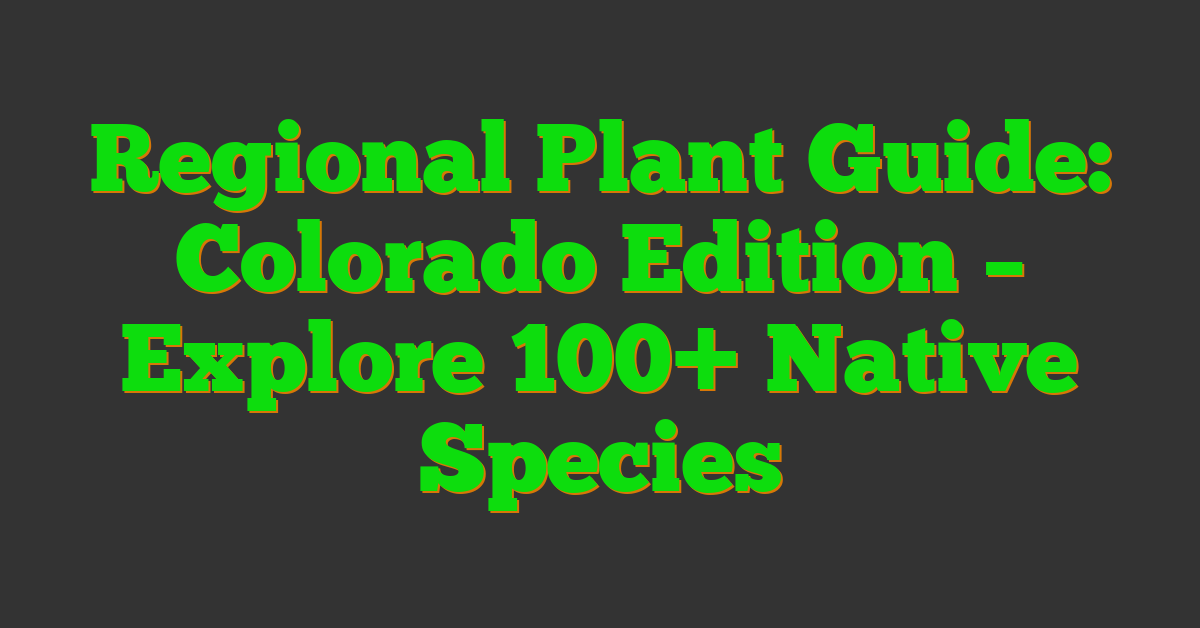Colorado’s diverse landscapes—from towering Rockies to expansive plains—are home to an incredible variety of plants. I’ve always been fascinated by how each region thrives with its unique flora, adapting to the changing elevations and climates.

In this guide, I’ll take you on a journey through Colorado’s plant life, highlighting the best species to look out for in different areas. Whether you’re a seasoned botanist or just love spending time outdoors, you’ll find tips and insights to enhance your exploration of the Centennial State’s natural beauty.
Overview of Regional Plant Guide: Colorado Edition
I created this guide to showcase Colorado’s diverse plant life across its unique regions. It serves as a valuable resource for identifying and understanding local flora.
Purpose and Scope
This guide details over 100 native plant species found in Colorado’s various ecosystems. It covers mountainous areas, plains, forests, and wetlands, highlighting each plant’s adaptations, blooming periods, and preferred habitats. By providing specific information, I aim to assist readers in exploring and conserving Colorado’s natural plant diversity.
Target Audience
Outdoor enthusiasts seeking to identify plants during hikes, botanists researching regional flora, gardeners interested in native species, and educators teaching about Colorado’s biodiversity benefit from this guide. Whether you’re a seasoned botanist or a curious nature lover, this resource supports your exploration and appreciation of Colorado’s plant life.
Key Features
This section highlights the main components of the Colorado regional plant guide, designed to enhance your exploration and understanding of the state’s native flora.
Comprehensive Plant Listings
I include over 100 native plant species, categorized by ecosystems such as mountainous regions, plains, forests, and wetlands. Each listing provides detailed information on plant adaptations, blooming periods, and preferred habitats, making it easier to identify and appreciate Colorado’s diverse flora.
Regional Distribution Maps
I offer detailed maps showing the distribution of each plant species across Colorado’s various regions. These maps help you pinpoint where to find specific plants, facilitating targeted exploration and study of the state’s unique plant biodiversity.
Benefits for Gardeners and Landscapers
Using the Colorado Regional Plant Guide transforms gardening and landscaping projects. It offers precise information to cultivate vibrant, sustainable outdoor environments.
Enhancing Biodiversity
Integrating native Colorado plants boosts local biodiversity. Diverse species support pollinators, birds, and beneficial insects. For example, planting asters, penstemons, and pines attracts various wildlife. Healthy ecosystems minimize pest problems and enhance natural resilience.
Sustainable Landscaping Practices
Choosing native plants fosters sustainable landscaping. These species require less water, cutting irrigation needs by up to 50%. They thrive in Colorado’s climate, reducing reliance on fertilizers and pesticides. Implementing drought-tolerant grasses and native shrubs lowers maintenance efforts and environmental impact.
Comparison with Other Plant Guides
When compared to other plant guides, the Colorado Edition offers tailored information that truly stands out.
Unique Colorado-Specific Information
This guide focuses exclusively on Colorado’s native plants, detailing their adaptations to local climates and elevations. It includes regional distribution maps showcasing precise locations for over 100 species. Each plant entry highlights specific blooming periods and habitat preferences unique to Colorado’s diverse ecosystems.
User-Friendly Format
The guide features an intuitive layout with clear categories based on ecosystems. It uses high-quality images for easy identification and includes interactive maps for locating plant species. Additionally, the concise descriptions and organized listings make the information accessible for both beginners and experienced botanists.
How to Use the Guide Effectively
Maximize your experience with the Colorado Regional Plant Guide by understanding its structure and applications. Here’s how to make the most of this resource.
Navigating the Sections
Explore the guide efficiently by familiarizing yourself with its key sections. If you start with plant listings categorized by ecosystem, you’ll find it easier to locate species relevant to your area. Each listing includes:
- Plant Adaptations: Details on how plants thrive in Colorado’s climates.
- Blooming Periods: Specific times when each plant flowers.
- Preferred Habitats: Ideal environments for growth.
- Distribution Maps: Visual representations of where plants are found across the state.
Using these sections, you can quickly identify and study plants in different regions, enhancing your exploration of Colorado’s diverse flora.
Practical Applications
Apply the guide’s information to various activities to enhance your engagement with Colorado’s plant life. Whether you’re gardening, hiking, or educating others, the guide offers valuable insights. For gardeners, integrating native plants supports local biodiversity and reduces maintenance. If you’re planning a hike, use the distribution maps to spot specific species along your trail. Educators can utilize the detailed plant information to create informative lessons about regional ecosystems. By leveraging these practical applications, you can effectively utilize the guide to enrich your connection with Colorado’s natural environment.
Conclusion
Exploring Colorado’s plant life has been an incredible journey for me. Each region offers its own unique beauty and surprises, making every adventure worthwhile.
« How to Build a Stone Bench: Step-by-Step DIY Guide for Your Garden How to Create a Hardscape Play Area: Ultimate Step-by-Step Backyard Guide »
I hope this guide inspires you to get out and discover the amazing flora that Colorado has to offer. Happy exploring and enjoy connecting with the natural world around you!
















